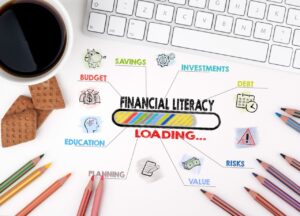The government is taking significant steps to support and expand Canadian financial literacy, led by the Financial Consumer Agency of Canada (FCAC). These initiatives empower Canadians to make informed financial decisions and enhance their well-being. As financial topics become more complicated and digital, ensuring everyone has access to trustworthy resources and education is more critical than ever. Financial literacy helps Canadians of all ages navigate spending, saving, borrowing, and investing decisions confidently.
Financial Literacy Month
Every November, the FCAC leads the Financial Literacy Month (FLM) campaign. The 2025 theme, “Talk Money,” encourages Canadians to break the stigma around discussing finances. By fostering open conversations, the campaign aims to improve transparency and learning, as people benefit from each other’s experiences. Activities such as the “$15 Stretch Challenge” help Canadians discover strategies for making money go further, and digital tools provide accessible ways to manage and understand personal finances.
FLM also highlights support for various communities, creating space for older people, women, newcomers, Indigenous Peoples, and those facing income barriers to participate fully. By making personal finance discussions mainstream, Financial Literacy Month works to boost confidence and skill-building across Canada. By normalizing discussions about money, Financial Literacy Month reduces isolation and builds financial confidence at every age and income level.
National Financial Literacy Strategy 2021-2026
The National Financial Literacy Strategy 2021-2026 is a five-year plan developed by FCAC to create a more accessible and inclusive financial ecosystem for everyone in Canada. This strategy reflects extensive consultations with stakeholders, ranging from community groups to academics, specifically including the perspectives of Indigenous Peoples, older people, women, newcomers, and people with low incomes.
Goals and priorities
- Reduce barriers to financial resilience, including digital and systemic obstacles faced by Canadians. For instance, ensuring plain language in financial communications and simplifying digital interfaces and processes.
- Catalyze actions among stakeholders (e.g., banks, nonprofits, governments) to design and deliver effective programs and impactful interventions.
- Collaborate across sectors to promote evidence-based interventions. This helps ensure tools and resources are informed by the realities Canadians face every day, from fraud prevention for older people to budget education for youth.
The overall vision is a Canada where everyone has the capacity and opportunity to build financial resilience, especially in an increasingly digital economy. The strategy’s focus on reducing barriers and fostering collaboration recognizes that true financial well-being depends on both individual knowledge and systemic support.
Financial literacy tools, dashboards, and research
The FCAC provides a variety of tools and resources designed to empower Canadians to make confident financial decisions. These resources support Canadians as they build financial knowledge and, in turn, financial confidence.
Digital tools and budget resources
FCAC provides user-friendly tools for budgeting, credit and banking calculations, and learning about financial products. These tools are freely accessible and designed for all ages. For example:
- The online Budget Planner helps users track income and expenses, set savings goals, and identify areas for improvement.
- A financial literacy self-assessment quiz to help you become aware of where your financial knowledge gaps are so you can fill them in.
- The Bank Account Comparison Tool assists Canadians in choosing the right account for their needs.
These tools are free, multilingual, and targeted to support Canadians regardless of age, tech skill, or income.
Financial Well-Being dashboard
The RDX (Research Data and Insight Exchange) Dashboard highlights trends in Canadians’ financial well-being using data from several national surveys. This includes indicators such as household savings rates, prevalence of emergency funds, and financial stress levels. For example, in recent years, the dashboard shows:
- In 2024, 61% of Canadians reported being able to cover an unexpected $500 expense, while 39% would have difficulty. This highlights ongoing gaps in emergency savings across the population.
- Nearly half of the surveyed Canadians felt some level of financial stress, illustrating persistent challenges and the need for ongoing support.
- The dashboard also tracks Canadians’ debt management ability. For example, approximately 70% of households were current on all debt payments, showing relative resilience amid economic challenges.
- The digital divide remains a concern. The dashboard tracks access to online banking and digital financial services, showing that some older adults and rural populations face barriers that the FCAC strategy aims to reduce.
Besides tracking national indicators like savings rates, emergency fund access, and financial stress, RDX allows stakeholders to share best practices and assess progress toward strategy goals.
The Canadian Financial Capability Survey
One of the cornerstone research efforts, the Canadian Financial Capability Survey (CFCS), measures how Canadians manage money, make financial decisions, and approach budgeting, saving, and debt. Recent surveys reveal:
- 63% of Canadians felt confident in their ability to manage day-to-day finances, yet only 46% said they had a budget.
- Many Canadians report difficulty keeping up with bills and payments in the wake of pandemic disruptions, which highlighted gaps in financial resilience.
- Survey data informs policy interventions, such as programs targeting youth budgeting and fraud protection for older people.
Research initiatives and toolkits
Ongoing FCAC research, including a COVID-19 series, tracks how Canadians’ finances and behaviours shift during periods of crisis. Notably, the pandemic increased financial vulnerability among lower-income Canadians but also spurred creative community responses and new digital outreach initiatives, like:
- Financial Toolkit: An interactive learning program covering everything from basic budgeting to more complex financial topics.
Financial Literacy for Newcomers: Tailored support and programs in multiple languages, often run in collaboration with local agencies and settlement organizations.
Key takeaways
Canada’s financial literacy initiatives work together to improve knowledge, build confidence, and promote sound financial choices for all Canadians. By making resources available and fostering a culture of openness around financial topics, Canadians are empowered to better withstand financial stress, adapt to change, and achieve their financial goals. The ongoing efforts of the FCAC and its partners ensure that financial literacy remains a national priority and that much-needed support reaches the people who need it the most. If you’re currently dealing with debt and need guidance, contact one of our trained credit counsellors for advice – they can help you figure out which debt solution could be the right fit for your specific situation.





